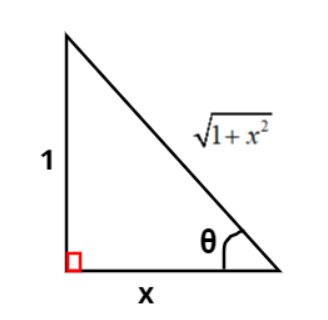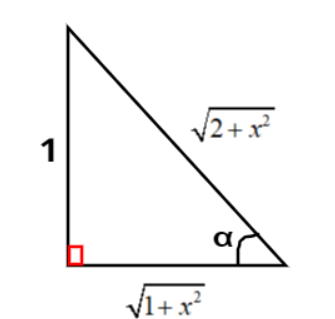
If inverse trigonometric function is given as $\cos \left\{ {{{\tan }^{ - 1}}\left( {\sin \left( {{{\cot }^{ - 1}}x} \right)} \right)} \right\} = {\left( {\dfrac{{{x^a} + 1}}{{{x^b} + 2}}} \right)^{\dfrac{1}{c}}}$. Find the value of $a + b + c$.
$
{\text{A}}{\text{. 3}} \\
{\text{B}}{\text{. 4}} \\
{\text{C}}{\text{. 5}} \\
{\text{D}}{\text{. 6}} \\
$
Answer
600.6k+ views
Hint: Here, we will be converting the inverse trigonometric functions into a trigonometric function next to the inverse trigonometric function so that they are just left with the angle.
Complete step-by-step solution:
Given, $\cos \left\{ {{{\tan }^{ - 1}}\left( {\sin \left( {{{\cot }^{ - 1}}x} \right)} \right)} \right\} = {\left( {\dfrac{{{x^a} + 1}}{{{x^b} + 2}}} \right)^{\dfrac{1}{c}}}{\text{ }} \to {\text{(1)}}$
Consider $\theta = {\cot ^{ - 1}}x \Rightarrow \cot \theta = x$, the diagram corresponding to this function is shown in Figure 1.

Equation (1), becomes
$\cos \left\{ {{{\tan }^{ - 1}}\left( {\sin \theta } \right)} \right\} = {\left( {\dfrac{{{x^a} + 1}}{{{x^b} + 2}}} \right)^{\dfrac{1}{c}}}{\text{ }} \to {\text{(2)}}$
Here we will convert this inverse cotangent trigonometric function into inverse sine trigonometric function.
$\theta = {\cot ^{ - 1}}x \Rightarrow \cot \theta = \dfrac{x}{1} = \dfrac{{{\text{Base}}}}{{{\text{Perpendicular}}}}$
$ \Rightarrow {\text{Base}} = x$ and ${\text{Perpendicular}} = 1$
As according to Pythagoras theorem in a right angled triangle, we can write
${\left( {{\text{Hypotenuse}}} \right)^2} = {\left( {{\text{Perpendicular}}} \right)^2}{\text{ + }}{\left( {{\text{Base}}} \right)^2} \Rightarrow {\left( {{\text{Hypotenuse}}} \right)^2} = {1^2} + {x^2} \Rightarrow {\text{Hypotenuse}} = \sqrt {1 + {x^2}} $ As, $\sin \theta = \dfrac{{{\text{Perpendicular}}}}{{{\text{Hypotenuse}}}} = \dfrac{1}{{\sqrt {1 + {x^2}} }} \Rightarrow \theta = {\sin ^{ - 1}}\left[ {\dfrac{1}{{\sqrt {1 + {x^2}} }}} \right]$
Hence equation (2) becomes
$\cos \left\{ {{{\tan }^{ - 1}}\left( {\sin \left( {{{\sin }^{ - 1}}\left[ {\dfrac{1}{{\sqrt {1 + {x^2}} }}} \right]} \right)} \right)} \right\} = {\left( {\dfrac{{{x^a} + 1}}{{{x^b} + 2}}} \right)^{\dfrac{1}{c}}}$
We know that $\sin \left( {{{\sin }^{ - 1}}\beta } \right) = \beta $, the above equation becomes
$ \Rightarrow \cos \left\{ {{{\tan }^{ - 1}}\left( {\dfrac{1}{{\sqrt {1 + {x^2}} }}} \right)} \right\} = {\left( {\dfrac{{{x^a} + 1}}{{{x^b} + 2}}} \right)^{\dfrac{1}{c}}}{\text{ }} \to {\text{(3)}}$
Now let ${\tan ^{ - 1}}\left( {\dfrac{1}{{\sqrt {1 + {x^2}} }}} \right) = \alpha \Rightarrow \tan \alpha = \dfrac{1}{{\sqrt {1 + {x^2}} }} = \dfrac{{{\text{Perpendicular}}}}{{{\text{Base}}}}$, the diagram corresponding to this function is shown in Figure 2.

Equation (3) becomes,
$ \Rightarrow \cos \alpha = {\left( {\dfrac{{{x^a} + 1}}{{{x^b} + 2}}} \right)^{\dfrac{1}{c}}}{\text{ }} \to {\text{(4)}}$
Here we will convert this inverse tangent trigonometric function into inverse cosine trigonometric function.
$ \Rightarrow {\text{Perpendicular}} = 1$ and ${\text{Base}} = \sqrt {1 + {x^2}} $
Again according to Pythagoras theorem in a right angled triangle, we can write
$
{\left( {{\text{Hypotenuse}}} \right)^2} = {\left( {{\text{Perpendicular}}} \right)^2}{\text{ + }}{\left( {{\text{Base}}} \right)^2} \Rightarrow {\left( {{\text{Hypotenuse}}} \right)^2} = {1^2} + {\left( {\sqrt {1 + {x^2}} } \right)^2} = 1 + 1 + {x^2} \\
\Rightarrow {\text{Hypotenuse}} = \sqrt {2 + {x^2}} \\
$
As, $\cos \alpha = \dfrac{{{\text{Base}}}}{{{\text{Hypotenuse}}}} = \dfrac{{\sqrt {1 + {x^2}} }}{{\sqrt {2 + {x^2}} }} = \sqrt {\dfrac{{1 + {x^2}}}{{2 + {x^2}}}} \Rightarrow \alpha = {\cos ^{ - 1}}\left[ {\sqrt {\dfrac{{1 + {x^2}}}{{2 + {x^2}}}} } \right]$
Hence equation (4) becomes
$ \Rightarrow \cos \left\{ {{{\cos }^{ - 1}}\left[ {\sqrt {\dfrac{{1 + {x^2}}}{{2 + {x^2}}}} } \right]} \right\} = {\left( {\dfrac{{{x^a} + 1}}{{{x^b} + 2}}} \right)^{\dfrac{1}{c}}}$
We know that $\cos \left( {{{\cos }^{ - 1}}\beta } \right) = \beta $, the above equation becomes
$
\Rightarrow \sqrt {\dfrac{{1 + {x^2}}}{{2 + {x^2}}}} = {\left( {\dfrac{{{x^a} + 1}}{{{x^b} + 2}}} \right)^{\dfrac{1}{c}}} \\
\Rightarrow {\left( {\dfrac{{{x^2} + 1}}{{{x^2} + 2}}} \right)^{\dfrac{1}{2}}} = {\left( {\dfrac{{{x^a} + 1}}{{{x^b} + 2}}} \right)^{\dfrac{1}{c}}}{\text{ }} \to {\text{(5)}} \\
$
On comparing equation (5), the values of the unknowns obtained are $a = 2$, $b = 2$ and $c = 2$
Therefore, $a + b + c = 2 + 2 + 2 = 6$
Hence, option D is correct.
Note: In these types of problems, conversion of trigonometric functions is required so that the next trigonometric function is eliminated with the inverse trigonometric function.
Complete step-by-step solution:
Given, $\cos \left\{ {{{\tan }^{ - 1}}\left( {\sin \left( {{{\cot }^{ - 1}}x} \right)} \right)} \right\} = {\left( {\dfrac{{{x^a} + 1}}{{{x^b} + 2}}} \right)^{\dfrac{1}{c}}}{\text{ }} \to {\text{(1)}}$
Consider $\theta = {\cot ^{ - 1}}x \Rightarrow \cot \theta = x$, the diagram corresponding to this function is shown in Figure 1.

Equation (1), becomes
$\cos \left\{ {{{\tan }^{ - 1}}\left( {\sin \theta } \right)} \right\} = {\left( {\dfrac{{{x^a} + 1}}{{{x^b} + 2}}} \right)^{\dfrac{1}{c}}}{\text{ }} \to {\text{(2)}}$
Here we will convert this inverse cotangent trigonometric function into inverse sine trigonometric function.
$\theta = {\cot ^{ - 1}}x \Rightarrow \cot \theta = \dfrac{x}{1} = \dfrac{{{\text{Base}}}}{{{\text{Perpendicular}}}}$
$ \Rightarrow {\text{Base}} = x$ and ${\text{Perpendicular}} = 1$
As according to Pythagoras theorem in a right angled triangle, we can write
${\left( {{\text{Hypotenuse}}} \right)^2} = {\left( {{\text{Perpendicular}}} \right)^2}{\text{ + }}{\left( {{\text{Base}}} \right)^2} \Rightarrow {\left( {{\text{Hypotenuse}}} \right)^2} = {1^2} + {x^2} \Rightarrow {\text{Hypotenuse}} = \sqrt {1 + {x^2}} $ As, $\sin \theta = \dfrac{{{\text{Perpendicular}}}}{{{\text{Hypotenuse}}}} = \dfrac{1}{{\sqrt {1 + {x^2}} }} \Rightarrow \theta = {\sin ^{ - 1}}\left[ {\dfrac{1}{{\sqrt {1 + {x^2}} }}} \right]$
Hence equation (2) becomes
$\cos \left\{ {{{\tan }^{ - 1}}\left( {\sin \left( {{{\sin }^{ - 1}}\left[ {\dfrac{1}{{\sqrt {1 + {x^2}} }}} \right]} \right)} \right)} \right\} = {\left( {\dfrac{{{x^a} + 1}}{{{x^b} + 2}}} \right)^{\dfrac{1}{c}}}$
We know that $\sin \left( {{{\sin }^{ - 1}}\beta } \right) = \beta $, the above equation becomes
$ \Rightarrow \cos \left\{ {{{\tan }^{ - 1}}\left( {\dfrac{1}{{\sqrt {1 + {x^2}} }}} \right)} \right\} = {\left( {\dfrac{{{x^a} + 1}}{{{x^b} + 2}}} \right)^{\dfrac{1}{c}}}{\text{ }} \to {\text{(3)}}$
Now let ${\tan ^{ - 1}}\left( {\dfrac{1}{{\sqrt {1 + {x^2}} }}} \right) = \alpha \Rightarrow \tan \alpha = \dfrac{1}{{\sqrt {1 + {x^2}} }} = \dfrac{{{\text{Perpendicular}}}}{{{\text{Base}}}}$, the diagram corresponding to this function is shown in Figure 2.

Equation (3) becomes,
$ \Rightarrow \cos \alpha = {\left( {\dfrac{{{x^a} + 1}}{{{x^b} + 2}}} \right)^{\dfrac{1}{c}}}{\text{ }} \to {\text{(4)}}$
Here we will convert this inverse tangent trigonometric function into inverse cosine trigonometric function.
$ \Rightarrow {\text{Perpendicular}} = 1$ and ${\text{Base}} = \sqrt {1 + {x^2}} $
Again according to Pythagoras theorem in a right angled triangle, we can write
$
{\left( {{\text{Hypotenuse}}} \right)^2} = {\left( {{\text{Perpendicular}}} \right)^2}{\text{ + }}{\left( {{\text{Base}}} \right)^2} \Rightarrow {\left( {{\text{Hypotenuse}}} \right)^2} = {1^2} + {\left( {\sqrt {1 + {x^2}} } \right)^2} = 1 + 1 + {x^2} \\
\Rightarrow {\text{Hypotenuse}} = \sqrt {2 + {x^2}} \\
$
As, $\cos \alpha = \dfrac{{{\text{Base}}}}{{{\text{Hypotenuse}}}} = \dfrac{{\sqrt {1 + {x^2}} }}{{\sqrt {2 + {x^2}} }} = \sqrt {\dfrac{{1 + {x^2}}}{{2 + {x^2}}}} \Rightarrow \alpha = {\cos ^{ - 1}}\left[ {\sqrt {\dfrac{{1 + {x^2}}}{{2 + {x^2}}}} } \right]$
Hence equation (4) becomes
$ \Rightarrow \cos \left\{ {{{\cos }^{ - 1}}\left[ {\sqrt {\dfrac{{1 + {x^2}}}{{2 + {x^2}}}} } \right]} \right\} = {\left( {\dfrac{{{x^a} + 1}}{{{x^b} + 2}}} \right)^{\dfrac{1}{c}}}$
We know that $\cos \left( {{{\cos }^{ - 1}}\beta } \right) = \beta $, the above equation becomes
$
\Rightarrow \sqrt {\dfrac{{1 + {x^2}}}{{2 + {x^2}}}} = {\left( {\dfrac{{{x^a} + 1}}{{{x^b} + 2}}} \right)^{\dfrac{1}{c}}} \\
\Rightarrow {\left( {\dfrac{{{x^2} + 1}}{{{x^2} + 2}}} \right)^{\dfrac{1}{2}}} = {\left( {\dfrac{{{x^a} + 1}}{{{x^b} + 2}}} \right)^{\dfrac{1}{c}}}{\text{ }} \to {\text{(5)}} \\
$
On comparing equation (5), the values of the unknowns obtained are $a = 2$, $b = 2$ and $c = 2$
Therefore, $a + b + c = 2 + 2 + 2 = 6$
Hence, option D is correct.
Note: In these types of problems, conversion of trigonometric functions is required so that the next trigonometric function is eliminated with the inverse trigonometric function.
Recently Updated Pages
Master Class 12 Business Studies: Engaging Questions & Answers for Success

Master Class 12 Economics: Engaging Questions & Answers for Success

Master Class 12 English: Engaging Questions & Answers for Success

Master Class 12 Maths: Engaging Questions & Answers for Success

Master Class 12 Social Science: Engaging Questions & Answers for Success

Master Class 12 Chemistry: Engaging Questions & Answers for Success

Trending doubts
What are the major means of transport Explain each class 12 social science CBSE

Which are the Top 10 Largest Countries of the World?

Draw a labelled sketch of the human eye class 12 physics CBSE

How much time does it take to bleed after eating p class 12 biology CBSE

Explain sex determination in humans with line diag class 12 biology CBSE

Differentiate between homogeneous and heterogeneous class 12 chemistry CBSE




